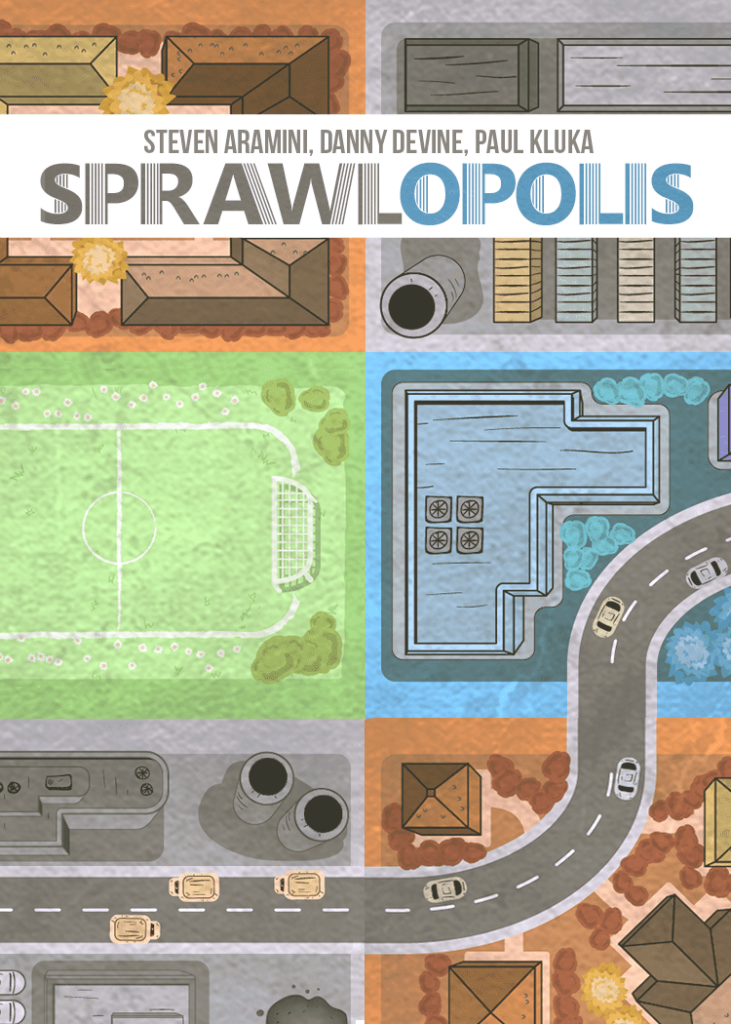How To Play: Sprawlopolis – Setup, rule summary and strategy
Becoming a Sprawlopolis master requires understanding the nuanced gameplay elements. It’s about smart card placement, prudent road use, and delicately balancing different scoring conditions. From setup to winning strategies, this guide gives you a concise overview to enhance your play and secure victories.

Overview
Welcome fellow city planners! Whether you’re a seasoned architect or just starting the concrete pour, this guide is your blueprint for success in Sprawlopolis. We’ll lay down the groundwork with a concise outline of the game’s rules and then navigate through the bustling streets of strategy. From card placement to road construction, I’ll share anecdotes and tips from my game nights that will elevate your play and put you on the path to victory.
What’s in the box
- 18 Game cards
- 4 Score cards
- 1 Start Player card
How To Play Sprawlopolis: Rules Summary
Setting Up The Game
Begin by shuffling the 18 cards that make up the Sprawlopolis deck. Draw three cards randomly to determine the scoring conditions for your game. Keep them visible for all players. Place the remaining cards together; this will serve as the draw pile. You’re now ready to start building your city.
Executing Gameplay
- On your turn, draw the top card of the draw pile.
- Place the card in your growing city, connecting edges with the same areas together whenever possible.
- Each card must be placed touching at least one other card either along its edge or corner.
- Pass the draw pile to the next player and continue the process until all cards are placed.
Securing Your Victory
- Once all cards are placed, score your city based on the three scoring conditions drawn at the start.
- You’ll also score one point for each square block of roads connecting correctly through your city.
- Lose one point for each road leading to the edge of the city.
- To win, accumulate more points than the target score on the back of the scoring condition cards.
Understanding Special Rules & Conditions
- If two scoring conditions contradict each other, both apply; strive to balance them to maximize points.
- Parks score double points if you meet specific configurations set by the scoring conditions.
- Each game is unique due to the random draw of scoring cards, so adapt your strategies accordingly.
Best Sprawlopolis Strategies
Mastering Scoring to Dominate Sprawlopolis
In Sprawlopolis, superb play hinges on grasping the volatile scoring objectives that shift each game. Initially, thoroughly review the scoring cards drawn—they dictate your strategic blueprint.
Adapting Strategies
Stay flexible; each round’s objectives could suggest contrasting tactics. Adapt your approach suitably to optimize points.
Analyzing Patterns
- Identify common elements—potentially, a park-heavy or road-centric game.
- Emphasize matching zones, as they effortlessly rack up points.
- Tailor your city’s layout with scoring patterns in mind.
Scoring Complexities
Moreover, sieve through objectives’ nuanced requirements for subtler scoring methods—those points can clinch a victory. Accumulate experience and you’ll nimbly intertwine these conditions with innate gameplay tact.
Mastering the Puzzle of Placement
The foundation of winning at Sprawlopolis is understanding the inherent puzzle in card placement. Strategic placement can make or break your city’s development. Transit options and communal areas depend on your choices. Let me share with you some personal tactics from my games:
- First, identify which zones you’ll expand. Weigh parks against industrial sections for points.
- Be flexible—your planned perfect spot may change as new cards come into play.
- Finally, leave room for growth to meet scoring cards’ future requirements.
Assessing Zones
Agile Placement
Future Proofing
Mastering the Roadways: A Well-Paved Path to Victory
When learning How To Play Sprawlopolis, the savvy placement of roads can mean the difference between a thriving city and a logistical nightmare. Playing with friends, I discovered that fewer, longer roads score more than a tangled mess. Here are three top strategies.
Strategic Road-Crafting
-
Connect neighborhoods purposefully to limit road ends, boosting your score effortlessly.
-
Mimic urban planners by extending existing roads; it’s neater and avoids penalties.
-
Play cards with demanding road networks earlier to mitigate their impact later on.
Efficient Expansion
Prioritize Problem Cards
Becoming a Master Planner
With the interplay between the scoring conditions, adept placement strategies, and careful management of road placement sensibly detailed in your quiver, you’re all set to become a master of city planning in ‘How To Play Sprawlopolis’. Remember, the best approach is to remain flexible and adapt your tactics as the game unfolds. Tap into the harmony of opportunism tempered by cunning foresight, and soon you’ll be racking up high scores and victories against your fellow city planners. So gather your friends, the city awaits your expert touch!
Want to know what we think of Sprawlopolis? Read our detailed review of Sprawlopolis here

